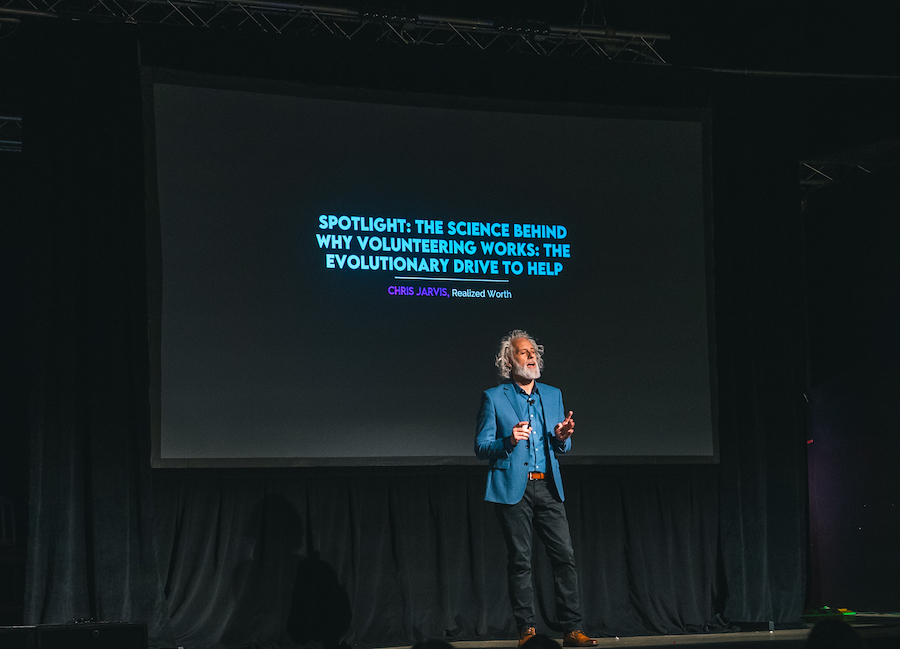Unraveling the Science Behind Why Volunteering Works


Chris Jarvis divided the audience at From Day One's Dallas conference into two groups and asked us to engage in a thought experiment. He said, “Imagine a happiness scale that ranges from one to ten, where ten is an amazing day, ranging all the way down to one, which would be a pretty rough day. Now, on your way to the conference today, you come across a crisp, clean $100 bill on the ground. There is no one around, so you pick it up and you put it in your pocket. How many points did your happiness level go up after you found the money on the ground?” The audience members in the first group reported their happiness points going up about one point.
On the opposite side of the room, the experiment was similar, except instead of spending the found money on yourself, you have to spend it on someone else. I was in the second group, and my response was among the majority. My happiness went up about three points.
Why do humans help other people? This is a fundamental question, and the idea behind the company Realized Worth, of which Jarvis is co-founder and chief strategy officer. Why do we help others, and what happens when businesses include volunteering in company culture?
This question, and the thought experiment Jarvis offered springs from a study conducted by Michael Norton at Harvard. Whether Norton carried out the study at Harvard, in Africa, or among colleagues, the results were largely the same. When the money was used to help someone else, happiness points were higher. The act of giving is what matters.
Jarvis said, “It comes down to a process in our brain called the Reward System. Think of a runner's high. Those naturally occurring endorphins in your brain are part of the brain reward system, and that is built-in neuro-behavior.”

In addition to the reward system, our brains have something called the pain matrix, and that means there are neurons in the brain that light up when you're in pain. But, these neurons can't tell the difference between being in pain and seeing somebody else’s pain. When our pain matrix lights up, we have one of two responses: intervene, or get up and leave. So, we feel compelled to help because it feels good to help, and we feel pain when we see somebody else in pain.
“But this last part presents us with a bit of a weird problem,” Jarvis said. “Because empathy is really only felt for those who are like us. It only works for our in-groups. What I mean by this comes from Social Identity Theory. Think of concentric circles of identity: Do we have enough commonality that we can connect? For every in-group that you're part of, it shares some of your interests and perspectives. And this is why we can feel great concern for people that are close to us in proximity and core alikeness.”
Jarvis continues, “For example, when catastrophe happens in another part of the world, we acknowledge it, but our pain matrix doesn’t light up. We are easily susceptible to dehumanizing those outside our groups. And this is the great crisis of humanity as a species, the ability to look at another group and say: We’re not safe because of them. They want what we've worked for.”
Luckily, there is a solution. “Because,” Jarvis said, “your brain tends to be plastic. It is incredibly flexible, like bones and cartilage when you're younger.” This flexibility is referred to as neuroplasticity.
In neuroplasticity, when we are confronted with a situation that doesn’t fit our expectations, a chemical called acetylcholine is secreted, and we grow new neural pathways. Jarvis said, “We need to have experiences that challenge the reality of what we think of as normal. And we need to be guided to this new place.”
When applying this concept to DEI initiatives in a company, Jarvis said, “Experience is key. You need to have the experience of the mind and the body, these two things together, for creating memories and for creating new neural pathways.”
For Jarvis, this is why employee volunteering is such an important feature of a company's program, especially regarding DEI. Without experiences to challenge the way our brains are wired, we can’t understand the human tendency to dehumanize another group.
Jarvis said, “Hidden biases stay quite hidden unless you go looking for them. And if the checklists are there, and we're meeting all the obligations, somehow, maybe we become more insulated. Because we have combined all of these external constructs, but never do the internal work. So, now we know just not how to show it, but that isn’t the direction we want to go. We want a workplace where we can bring your whole self, and we can belong.”
He said, “We need to inform people's experiences so that we don't carry these half understood biases and truths forward in life. Then, act. And that's where we'll see the behavior change. As a result of these experiences, we see ourselves differently in the world. Employee volunteering could be the best way to address this idea.”
Editor's note: From Day One thanks our partner, Realized Worth, for sponsoring this thought leadership spotlight.
Christina Cook is a freelance writer based in Dallas, TX, where she covers a variety of topics, with favorites including Art, Film, and live Theatre. Her work can be seen on Rawckus.com, RedDirtNation, and DallasArtBeat.com. Christina is also a creative writer. Her children’s book Your Hands Can Change the World was a 2017 regional bestseller.
The From Day One Newsletter is a monthly roundup of articles, features, and editorials on innovative ways for companies to forge stronger relationships with their employees, customers, and communities.